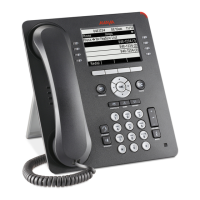Headset Adapter (DHA) units and 25 9641G removable CC-faceplate units
respectively.
If applicable, verify that the phone has been staged and administered with
applicable VPN settings as specified in the VPN Setup Guide for 9600 Series IP
Telephones (Document 16-602968).
Note:
For sites using wired headsets, the 9600 Series IP Deskphones support only the Jabra
GN1216 Headset cord and the Plantronics HIS headset cord. See your Avaya representative
for information.
Powering the deskphone
Caution:
Be careful to use the correct jack when plugging in the deskphone. The jacks are
located on the back of the telephone housing and are flanked by icons to
represent their correct use.
The 9608, 9611G, 9621G, and 9641G deskphones can be locally powered only
with the new Telephone Power Module (DC power jack), the IP Phone Single Port
PoE Injector (SPPOE-xx), which is available separately. In addition, all deskphones
support IEEE 802.3af-standard LAN-based power. Before installing a 9608, 9611G,
9621G, or 9641G Deskphone, verify with the LAN administrator whether the LAN
supports IEEE 802.3af, and if so, whether the deskphone should be powered locally
or by means of the LAN.
When you add devices like multiple button modules (all of which must be the same
model type) or a USB device to applicable IP Deskphones, the power class may
change.
Table 1: Impact of Additional Devices on Telephone Power over Ethernet
Power Class on page 15 shows the effect of such additions on the power class
and indicates how to set the IEEE power switch on the back of the deskphone to
accommodate different power needs. For USB devices, the telephone displays
instructions for any additional power needs upon registering the device.
Note:
The 9621G is a PoE Class 1 device with a 10/100 switch and does not have an
IEEE power switch.
Installing the Deskphone
14 H.323 Installation & Maintenance Guide R6.1 May 2011

